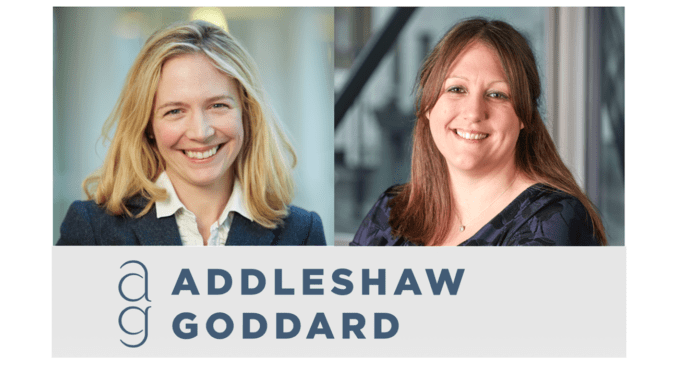
‘CLM implementation should be a lawyer-led process,’ explained Georgina Powling, a Partner at Addleshaw Goddard (AG), ‘it’s quite scary how much is done without legal involvement.’
Powling highlighted this with Kerry Westland, Head of Innovation & Legal Technology, during a discussion with Artificial Lawyer, and at a time when the CLM market has never been hotter.
The 2,000-person law firm is increasingly helping major corporates with CLM implementation projects; for example getting a corporate all set by helping with template creation and advice around legal workflows and compliance – steps that cannot be handled by just anyone, AG argues.
While creating templates may sound simple, the reality is that for a large company there may be dozens of documents, perhaps hundreds, that potentially need to be fed into the process. Interwoven with these, as Powling and Westland underlined, are a complex mix of legal issues where you can’t just throw a consultant at the problem.
This need for expert legal input is all the more acute now because the demand for CLM tools is growing strongly – yet inhouse legal teams often are not prepared for what needs to be done for those systems to deliver value, nor do they have the time to do it.
Hence the need for external legal support in the implementation process from experienced lawyers such as Powling backed by the extensive innovation and legal tech team under Westland. They have worked with several major corporations already on such matters, including Britvic, the drinks giant.
The move also comes at a time when tech and legal ops consultants, the Big Four, and many others are all trying to help companies bring in what are complex, multi-faceted pieces of technology centred around the DNA of the business – their contracts.
Why Do This?
AG no doubt could be very successful just providing ‘traditional legal services’, why help with CLM implementations?
The short answer from Powling and Westland (pictured left and right) is that the clients really want this input, moreover it’s simply an extension of what they already do, i.e. provide legal advice, it’s just that this is centred around a particular trigger point and need – a tech implementation.
‘CLM is not a product, it’s a process,’ stressed Powling, ‘and clients sometimes have solutions that they cannot get going.’
Those tech failures happen for a number of reasons, but Powling strongly believes that some clients have been over-sold what the tech could do, and consultants alone cannot ever really give a client what they need as CLM is inescapably connected to important legal issues that have to be addressed. If you just charge in, what you end up with is an expensive piece of tech that you cannot actually use because the legal dimension has not been sufficiently addressed.
Powling added that AG’s input can last more than a year, as so much legal work is needed. I.e. if you are told, ‘Hey, don’t worry, this is easy, just buy the CLM system and off you go,’ then you’re not getting the whole story.
‘Lawyers should be part of the process,’ Powling reiterated.
Westland then added that the firm had become a bit tired of CLM companies ‘leading things’. ‘The central part of all this is your contracts, that gets forgotten. ‘Tech can solve it’, is what people say, but you need a legal implementation partner,’ she explained.
Westland said that when CLM implementations go wrong they sometimes see ‘clients with their heads in their hands, and they [the inhouse lawyers] feel they are to blame’. However, she underlined that the problem stems from sellers not clearly communicating the sheer scale and legally focused nature of CLM projects.
So, as to the question why do this? The answer is: because the clients really need this and at the end of the day helping clients with their legal needs is what law firms are there for, even if in this case that help is tied closely to software use.
It’s Complicated
They both stressed that the CLM world, especially on the sales side, gives the impression that because modern CLM tools can bring efficiency, speed, simplicity and automation, that the process of installing such a system – and then maintaining it – is also simple and fast. This, they explained, was not the case.
They’re very much in favour of clients using CLM systems, they want to work hand-in-hand with the tech companies and also tech consultants, but they warn that you cannot skip key steps.
‘For example, a company may have templates made in Word from five years ago, but those won’t work now. Templates also need to be consolidated. How do you get sign off? This is legal work,’ Powling stated.
Westland and Powling then gave several other examples. What about understanding the difference between master and subsidiary contracts? How about understanding the wider legal and compliance framework certain contracts are part of? How are key clauses that a company will rely upon being defined? And then they added, who is going to be updating these templates?
Powling also pointed out that some CLM systems cannot handle key contracts that involve tables or diagrams – so those documents have to be redesigned, while remaining legally sound and coherent.
Plus there are related needs, such as choosing a CLM and developing the RFP. AG also helps with this.
Conclusion
AG’s message is that they are not seeking to compete with the tech companies, in fact they want to work very closely with them, they just want to make sure their clients get the same kind of end result they’d expect on any other matter that had a legal dimension.
And as Powling and Westland made very clear, CLM without expert legal input is a recipe for things going wrong. Given how on fire the market for this tech is now it looks to be the right kind of offering at the right time.
1 Trackback / Pingback
Comments are closed.